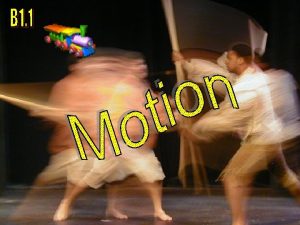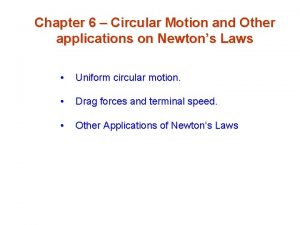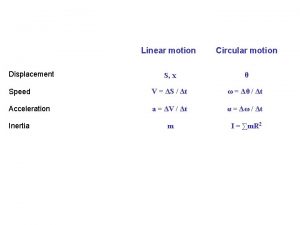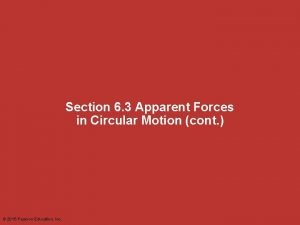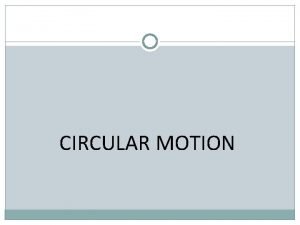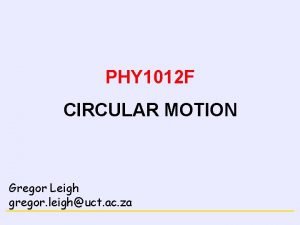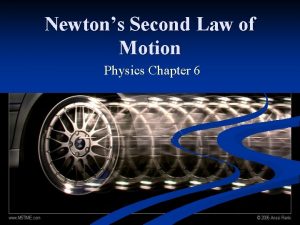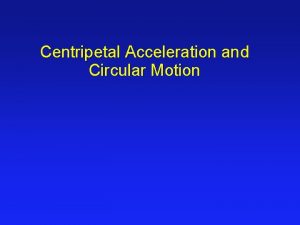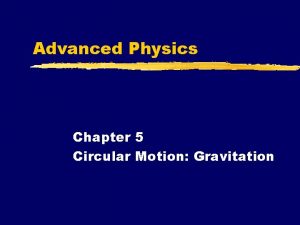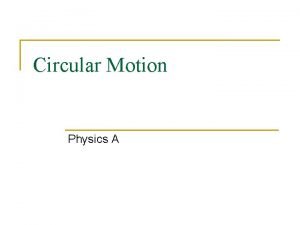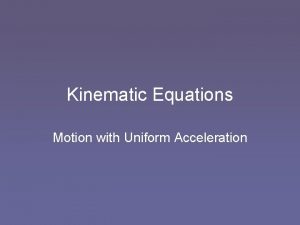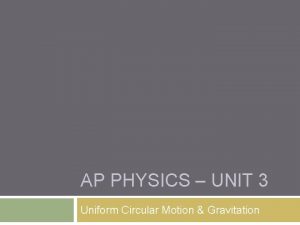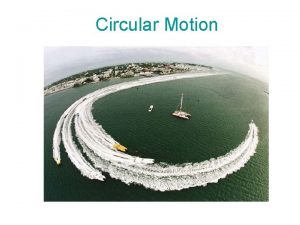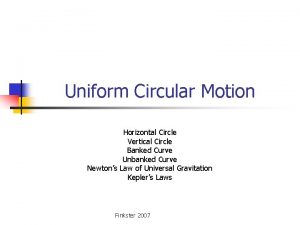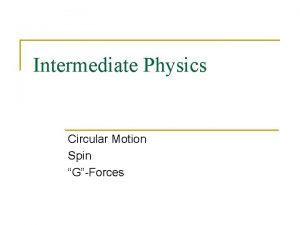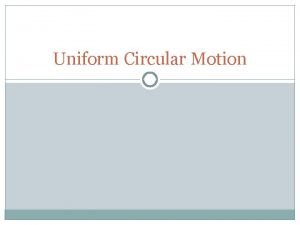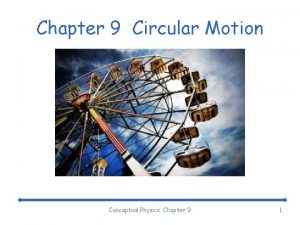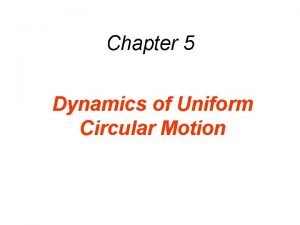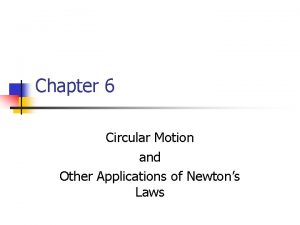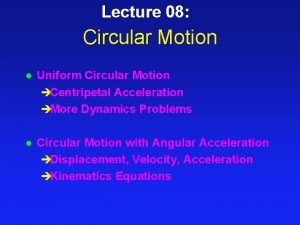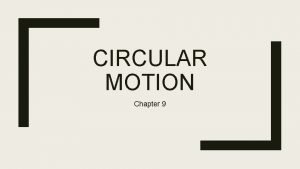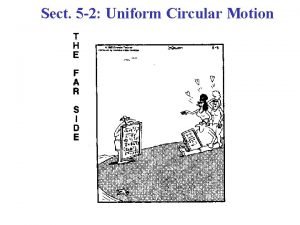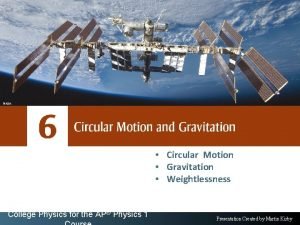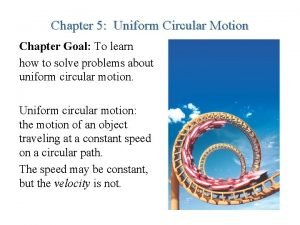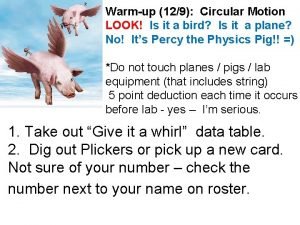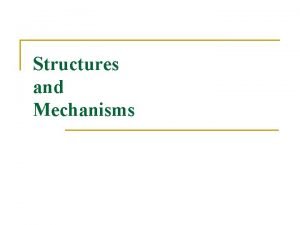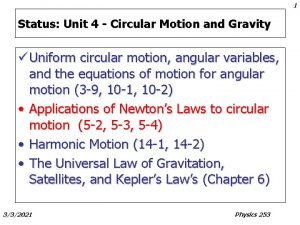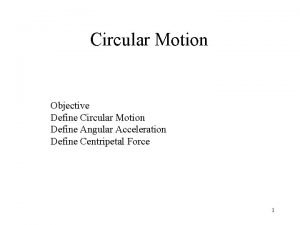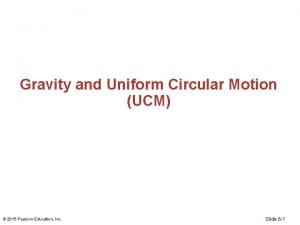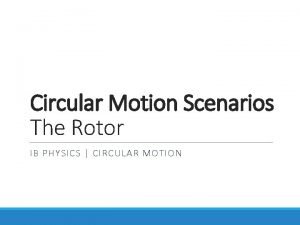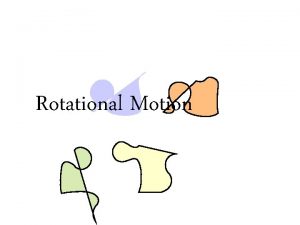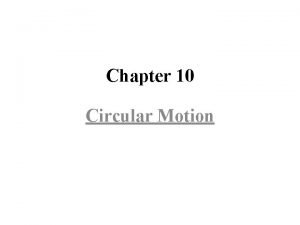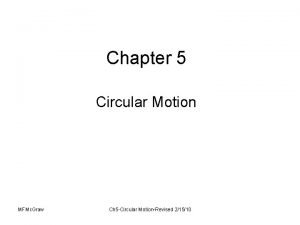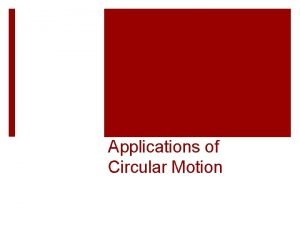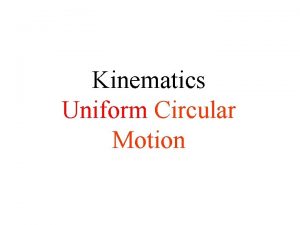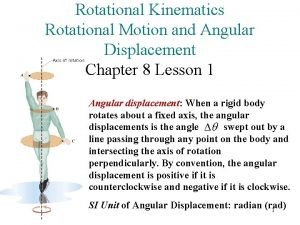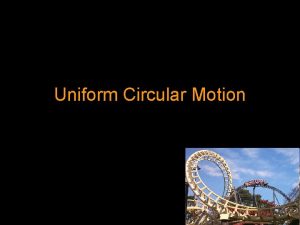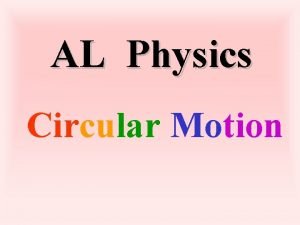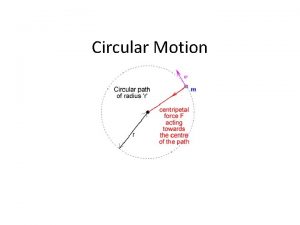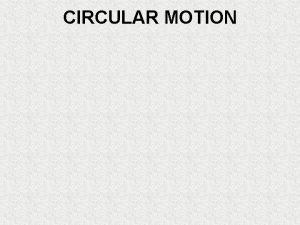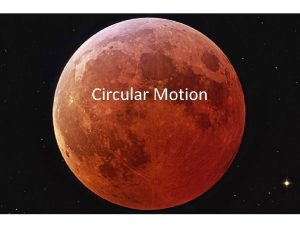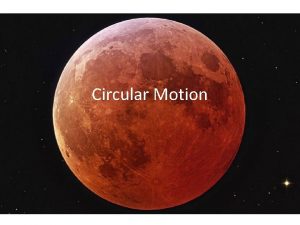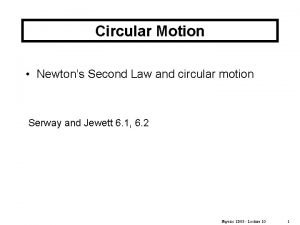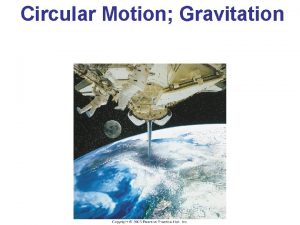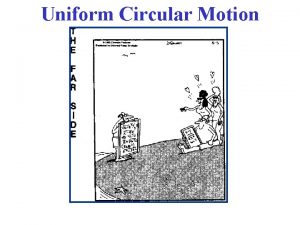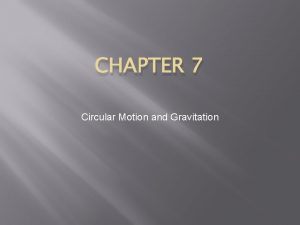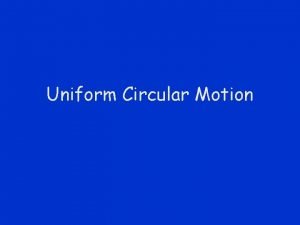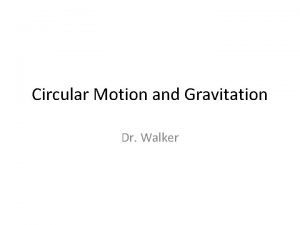Circular Motion Circular Motion Circular motion occurs when









































- Slides: 41

Circular Motion

Circular Motion Circular motion occurs when a force causes an object to curve in a full circle. The planets orbiting the sun, a child on a merry-go-round, and a basketball spinning on a fingertip are examples of circular motion. Each moves around its axis of rotation. The basketball’s axis runs from your finger up through the center of the ball. The child’s axis is a vertical line in the center of the merry-go-round. While their motions are similar, there is a difference. The ball’s axis is internal or inside the object. We say an object rotates about its axis when the axis is internal. A child on a merry-go-round moves around an axis that is external or outside him. An object revolves when it moves around an external axis.

Quiz

Angular Speed Angular speed When an object moves in a line, we can measure its linear speed. Linear speed is the distance traveled per unit of time. Angular speed is the amount an object in circular motion spins per unit of time. Angular speed can describe either the rate of revolving or the rate of rotating. Circular motion is described by angular speed. The angular speed is the rate at which something turns. The rpm, or rotation per minute, is commonly used for angular speed. Another common unit is angle per unit of time. There are 360 degrees in a full rotation, so one rotation per minute is the same angular speed as 360 degrees per minute.


Linear Speed

A merry-go-round makes 18 rotations in 3 minutes. What is its angular speed in rpm?

A child sits two meters from the center of a merrygo-round. How far does she travel during one revolution?

If the merry-go-round makes one revolution in 10 seconds, what is the child’s linear speed?

A compact disc is spinning with an angular speed of 3. 3 rotations per second. What is its angular speed in rotations per minute (rpm)? A) 200 rpm

The blades on a ceiling fan spin at 60 rotations per minute. The fan has a radius of 0. 5 meters. Calculate the linear speed of a point at the other edge of a blade in meters per second. 3. 14 m/s

The height of the London Eye is 135 m. Each rotation takes about 30 minutes. How fast would you be moving if you were on the London Eye? 2(3. 14)(67. 5)/(30 min*60 s) = 0. 24 m/s

A compact disc has a radius of 6 centimeters. a. What is its circumference in meters? b. If the cd rotates 4 times per second, what is the linear speed of a point on the outer edge of the cd? Give your answer in meters per second. c. What is the linear speed of a point 3 centimeters from the center of the cd? (Assume the angular speed has not changed). a) 0. 38 meter b) 1. 52 m/s c) 0. 75 m/s

A 95 -kg halfback makes a turn on the football field. The halfback sweeps out a path that is a portion of a circle with a radius of 12 -meters. The halfback makes a quarter of a turn around the circle in 2. 1 seconds. Determine the linear speed of the halfback. (2*3. 14*12 m)/4 = 18. 84 m 18. 84 m/2. 1 s = 8. 97 m/s (He makes ¼ of a circle)

A bicycle traveled a distance of 100 meters. The diameter of the wheel of this bicycle is 40 cm. Find the number of rotations of the wheel. 40 cm = 0. 4 m (2*3. 14*0. 2 m) = 1. 256 m 100 m / 1. 256 m = 79. 6 rotations

During their physics field trip to the amusement park, Tyler and Maria took a rider on the Whirligig. The Whirligig ride consists of long swings which spin in a circle at relatively high speeds. As part of their lab, Tyler and Maria estimate that the riders travel through a circle with a radius of 6. 5 m and make one turn every 5. 8 seconds. Determine the speed of the riders on the Whirligig.

A particle is moving around in a circle of radius R = 1. 5 m with a constant speed of 2 m/s. What is the angular velocity of the particle? C = (2*3. 14*1. 5) = 9. 42 m 2 m/s = 120 m per min 120/9. 42 = 17. 73 rpm

During the spin cycle of a washing machine, the clothes stick to the outer wall of the barrel as it spins at a rate as high as 1800 revolutions per minute. The radius of the barrel is 26 cm. Determine the speed of the clothes (in m/s) which are located on the wall of the spin barrel.

Circular Motion WS 1. 2. 3. 4. A) 1188 degrees/second B) 198 rpm A) 0. 38 m B) 1. 52 m/s C) 0. 75 m/s Slower A) 0. 83 m B) 1. 87 m C) 1205 revolutions D) 535 revolutions

Centripetal Force Any force that causes an object to move in a circle. The word centripetal means center seeking. For object's moving in circular motion, there is a net force acting towards the center which causes the object to seek the center.

Centripetal Force in Space




Centrifugal Force • Centrifugal Force IS NOT A FORCE. • It is caused by inertia giving the appearance of a force.

Centrifuge A machine with a rapidly rotating container that applies centrifugal force to its contents, typically to separate fluids of different densities (e. g. , cream from milk) or liquids from solids.






How Do Satellites Orbit?






Practice B Page 238 1. 2. 3. 4. 29. 6 kg 40. 0 m 40. 0 N 35. 0 m/s

The maximum speed with which a 945 -kg car makes a 180 -degree turn is 10. 0 m/s. The radius of the circle through which the car is turning is 25. 0 m. Determine the force of friction and the coefficient of friction acting upon the car.

A 4. 0 kg ball is attached to 0. 7 meter string and spun at 2. 0 meters/sec. What is the centripetal force?

A 4. 0 kg ball is attached to 0. 7 meter string and spun at 2. 0 meters/sec. What is the centripetal force? 22. 85 N
 Motion occurs when there is a change in speed.
Motion occurs when there is a change in speed. What are the five principles of hair design
What are the five principles of hair design What causes circular motion
What causes circular motion V = δs/δt
V = δs/δt Apparent forces in circular motion
Apparent forces in circular motion Circular motion formula
Circular motion formula Learning objectives for newton's laws of motion
Learning objectives for newton's laws of motion Physics
Physics Circular motion conceptual questions
Circular motion conceptual questions Circular motion summary
Circular motion summary Chapter 5 circular motion gravitation
Chapter 5 circular motion gravitation Circular motion
Circular motion Kinematic equations for circular motion
Kinematic equations for circular motion Ap physics unit 3 circular motion and gravitation
Ap physics unit 3 circular motion and gravitation Circular motion examples
Circular motion examples Vertical and horizontal circle
Vertical and horizontal circle Circular motion
Circular motion Uniform circular motion lab
Uniform circular motion lab State of rest and motion
State of rest and motion Conceptual physics chapter 9 circular motion answers
Conceptual physics chapter 9 circular motion answers Circular motion definition
Circular motion definition Circular motion applications
Circular motion applications Circular motion summary
Circular motion summary Circular motion definition
Circular motion definition Circular motion with constant speed
Circular motion with constant speed Circular motion images
Circular motion images How to solve circular motion problems
How to solve circular motion problems Centripetal acceleration symbol
Centripetal acceleration symbol Mechanism and structure
Mechanism and structure Circular motion
Circular motion Rotating space station physics problem
Rotating space station physics problem Apparent weight formula
Apparent weight formula Ib physics circular motion
Ib physics circular motion Circular motion is one dimensional or two dimensional
Circular motion is one dimensional or two dimensional Minimum velocity
Minimum velocity To mix foods lightly with a lifting motion
To mix foods lightly with a lifting motion Uniform circular motion
Uniform circular motion Chapter 10 circular motion
Chapter 10 circular motion Circular motion
Circular motion Applications of circular motion
Applications of circular motion Circular motion
Circular motion Si unit for angular displacement
Si unit for angular displacement
